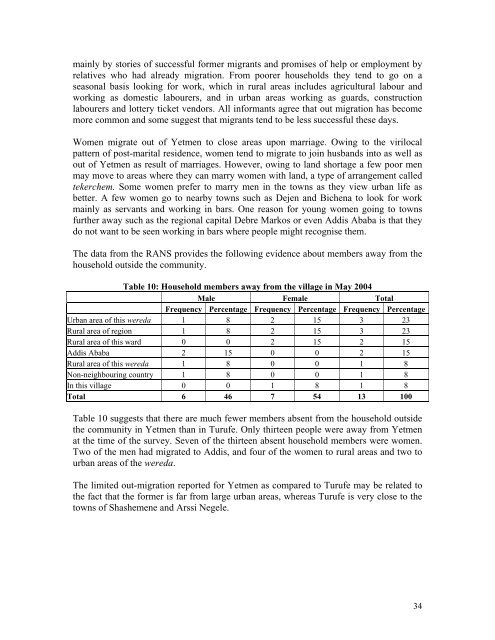Migration and Rural-Urban Linkages in Ethiopia
Migration and Rural-Urban Linkages in Ethiopia - Ethiopian Review
Migration and Rural-Urban Linkages in Ethiopia - Ethiopian Review
You also want an ePaper? Increase the reach of your titles
YUMPU automatically turns print PDFs into web optimized ePapers that Google loves.
ma<strong>in</strong>ly by stories of successful former migrants <strong>and</strong> promises of help or employment byrelatives who had already migration. From poorer households they tend to go on aseasonal basis look<strong>in</strong>g for work, which <strong>in</strong> rural areas <strong>in</strong>cludes agricultural labour <strong>and</strong>work<strong>in</strong>g as domestic labourers, <strong>and</strong> <strong>in</strong> urban areas work<strong>in</strong>g as guards, constructionlabourers <strong>and</strong> lottery ticket vendors. All <strong>in</strong>formants agree that out migration has becomemore common <strong>and</strong> some suggest that migrants tend to be less successful these days.Women migrate out of Yetmen to close areas upon marriage. Ow<strong>in</strong>g to the virilocalpattern of post-marital residence, women tend to migrate to jo<strong>in</strong> husb<strong>and</strong>s <strong>in</strong>to as well asout of Yetmen as result of marriages. However, ow<strong>in</strong>g to l<strong>and</strong> shortage a few poor menmay move to areas where they can marry women with l<strong>and</strong>, a type of arrangement calledtekerchem. Some women prefer to marry men <strong>in</strong> the towns as they view urban life asbetter. A few women go to nearby towns such as Dejen <strong>and</strong> Bichena to look for workma<strong>in</strong>ly as servants <strong>and</strong> work<strong>in</strong>g <strong>in</strong> bars. One reason for young women go<strong>in</strong>g to townsfurther away such as the regional capital Debre Markos or even Addis Ababa is that theydo not want to be seen work<strong>in</strong>g <strong>in</strong> bars where people might recognise them.The data from the RANS provides the follow<strong>in</strong>g evidence about members away from thehousehold outside the community.Table 10: Household members away from the village <strong>in</strong> May 2004Male Female TotalFrequency Percentage Frequency Percentage Frequency Percentage<strong>Urban</strong> area of this wereda 1 8 2 15 3 23<strong>Rural</strong> area of region 1 8 2 15 3 23<strong>Rural</strong> area of this ward 0 0 2 15 2 15Addis Ababa 2 15 0 0 2 15<strong>Rural</strong> area of this wereda 1 8 0 0 1 8Non-neighbour<strong>in</strong>g country 1 8 0 0 1 8In this village 0 0 1 8 1 8Total 6 46 7 54 13 100Table 10 suggests that there are much fewer members absent from the household outsidethe community <strong>in</strong> Yetmen than <strong>in</strong> Turufe. Only thirteen people were away from Yetmenat the time of the survey. Seven of the thirteen absent household members were women.Two of the men had migrated to Addis, <strong>and</strong> four of the women to rural areas <strong>and</strong> two tourban areas of the wereda.The limited out-migration reported for Yetmen as compared to Turufe may be related tothe fact that the former is far from large urban areas, whereas Turufe is very close to thetowns of Shashemene <strong>and</strong> Arssi Negele.34




![to read the full report [pdf, Amharic] - Ethiopian Review](https://img.yumpu.com/52737829/1/190x245/to-read-the-full-report-pdf-amharic-ethiopian-review.jpg?quality=85)











